-
Play
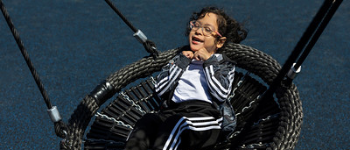
Inclusive playgrounds are designed for all ages and abilities.
-
Site
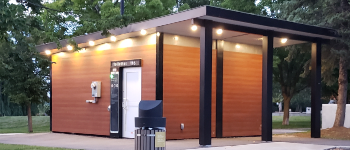
Upgrade your park or playground with smart, self-cleaning bathrooms
-
Sport
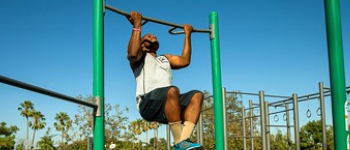
Outdoor fitness is exercise on another level.
-
Studio

Upgrade your park or playground with smart, self-cleaning bathrooms
-
Resources

Upgrade your park or playground with smart, self-cleaning bathrooms
-
About Us

Upgrade your park or playground with smart, self-cleaning bathrooms
-
Contact

Upgrade your park or playground with smart, self-cleaning bathrooms
THE ULTIMATE GUIDE TO Inclusive Playgrounds
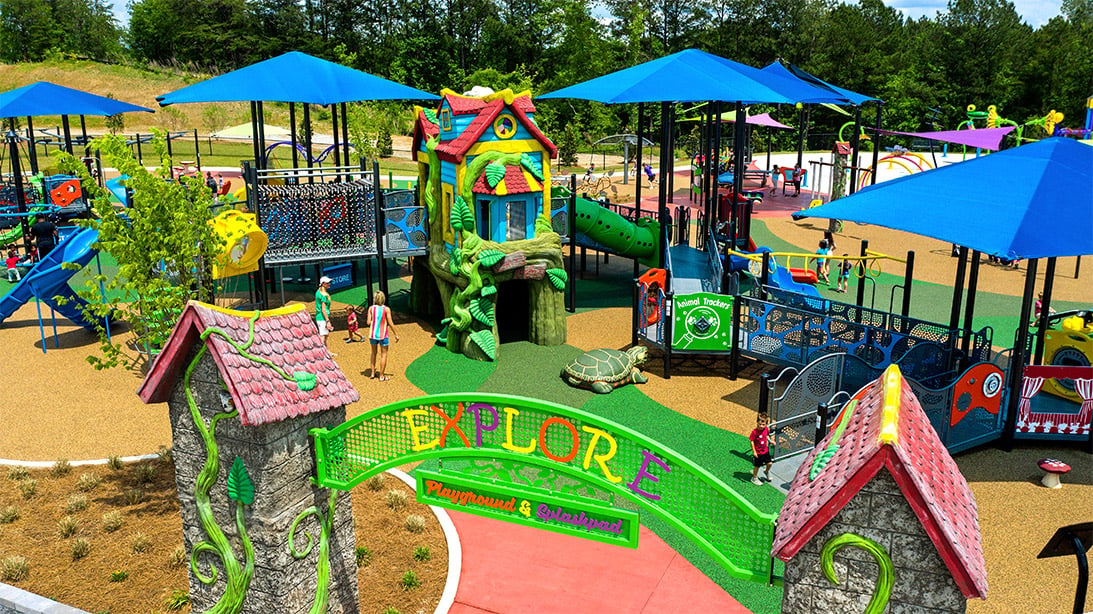
Table of Contents
Why?
According to Harvard Health, playing outside helps all children develop skills that help them plan, prioritize, troubleshoot, negotiate, and multitask. Additionally, every child – regardless of ability – needs at least 60 minutes of activity every day. For this to be possible, though, parks and playgrounds need to be inclusive.
But what does that mean?
When we talk about inclusive playgrounds, we're not only talking about the essentials like ramps and railings for mobility devices, but playground features that offer a certain mindset of openness, making children feel right at home at their playground. Now, the next question is: How exactly does one go about building a playground that's inclusive in all the ways that matter?
In this webpage, we'll explore everything you need to know about inclusivity regarding playgrounds, from definitions to products and more.
Let's dive in!
Want to Save This Guide for Later?
Download a free PDF by filling out the form below
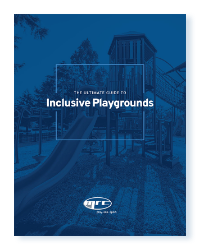
SECTION 1 Defining the Term "Inclusive Playground"

Before we get too far, let's start with the basics.
What is an inclusive playground?
An inclusive playground is an open and safe space carefully designed to promote play among children of differing abilities, ages, and communities. It gives children with and without any disability the same platform to play while breaking down barriers, both physically and socially. The inclusion created by these parks and playgrounds encourages children, adults, and families to experience the benefits of playing together.
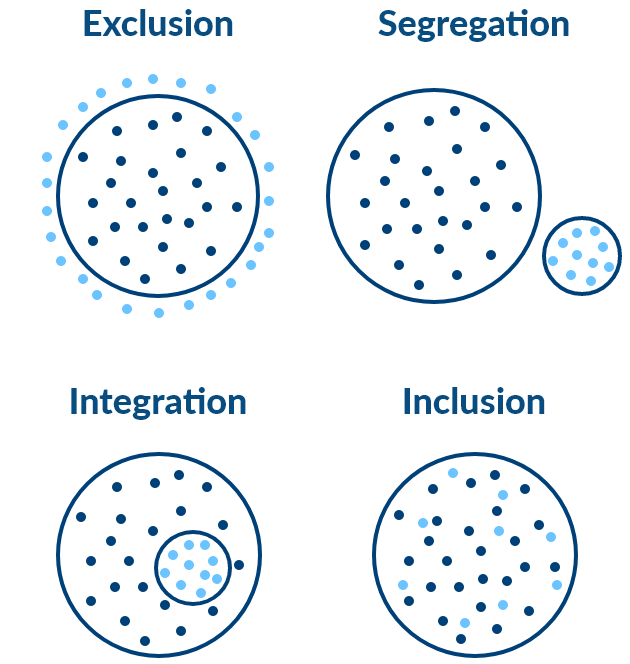

Ultimately, the goal of inclusive play is to address the needs of the whole child, which we'll examine later. First, take a look at different disabilities you must consider when planning your playground design.
SECTION 2 Facts About Different Disabilities

According to the CDC, "developmental disabilities are a group of conditions due to an impairment in either a person's learning, language, or other behavioral areas."
The U.S. Department of Education reports that nearly 6.7 million school-age children have disabilities. In fact, out of 1,000 children between three and 21, 85 will have some form of disability. Every person is unique, has unique purpose and values. Understanding that every person experiences subtle differences and challenges in their everyday lives will help us accommodate each child and person.

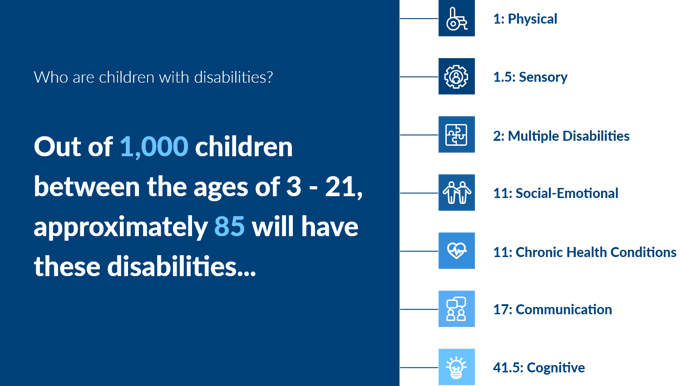
What are those forms? The most common are:
- Physical
- Sensory
- Multiple Disabilities
- Social-Emotional
- Chronic Health Conditions
- Communication
- Cognitive
What's more, 74% of parents believe it's essential for their kids to play with others, including those with differing disabilities. Seven out of 10 of those same parents strongly agree that playground equipment should be accessible to everyone.
So, keeping this in mind is critical when designing an inclusive playground. You also need to be mindful of the challenges that arise from having a disability.
What are some examples?
- Difficulty in moving playing materials or locations.
- Difficulty in manipulating play objects.
- Problems in engaging in socio-dramatic play.
- Not being able to think abstractly.
- Trouble in making other kids and adults understand their physical and mental limitations.
- Not being able to express their desire to play.
- Not able to show if they disliked an activity.
Often people, including playground designers, think that the term “disability” refers to someone using a mobility device. On the contrary, the 1994-1995 Survey of Income and Program Participation (SIPP) found that 26 million Americans (almost 1 in 10) have a severe disability, while only 1.8 million used a wheelchair and 5.2 million used a cane, crutches or walker (Americans with Disabilities 94-95). In other words, 74% of Americans who live with a severe disability do not use such devices.
Therefore, a disability cannot be determined solely by whether or not a person uses a mobility device. Disabilities are not always obvious to the eye, and can vary from mild limitations to severe challenges, from person to person.
The importance of inclusivity is further elevated when you consider The United Nations Conventions of the Rights of the Child and the Americans With Disabilities Act (ADA). In 1989, the United Nations clearly stated in Article 31 that, "Children have the right to relax and play, and to join in a wide range of cultural, artistic and other recreational activities." Just a year later, in 1990, the ADA made sure that clause included children with disabilities.
Let's look at that.
SECTION 3 The Americans With Disabilities Act (ADA) of 1990

Signed into law on July 26, 1990, the ADA prohibits "the discrimination against people with disabilities in several areas, including employment, transportation, public accommodations, communications and access to state and local government programs and services."
You might have guessed it, but a park or playground falls under the category "public accommodations." For many years, designers and developers didn't have much guidance to ensure equal access to all people in such public areas. However, in 2010, the ADA revised and released Standards for Accessible Design. All playground equipment or facilities constructed or altered on or after March 15, 2012 are subject to strict guidelines enforced by federal law.
That means your current or potential playground!
According to the ADA, to be accessible or inclusive, a playground must have the following:
- An accessible path from the building or parking lot to the edge of the play area.
- An accessible path from the edge of the play area to the play equipment.
- Surfacing that complies with ASTM 1951 (Determination of Accessibility of Surface Systems Under and Around Playground Equipment).
Additionally, once a child is in the play area, they must be able to access equipment. This can be made possible by either moving out of their mobility device onto the structure via a transfer station or by direct access in their mobility device. You can ensure access to equipment by adding features such as a ramp leading to a piece of equipment.
Achieving this is vital, which is why we recommend diligently research ADA policies.
SECTION 4 Key Terms to Know

We've thrown out many terminologies, such as the ADA and inclusivity. Still, there are several other vital definitions to understand when working on an inclusive playground project. Some of the most important terms to know include:
- Accessibility: Accessibility refers to the characteristics of products, services, and facilities that make them available to people with various disabilities.
- Accessible Design: Accessible design is a design process in which the needs of people with disabilities are specifically considered.
- Universal Design: The design of products and environments to be usable by all people to the greatest extent possible, without adaptation or specialized design.
- Compliant Design: Compliant designs, or compliant play structures, are made with physically disabled children in mind but not explicitly made for them.
- Inclusive Playground Design: Inclusive playground design is consistent with the concept of universal design. It recognizes everyone's right to participate fully and contribute to meaningful play.
- Accessible Route: An accessible route is a continuous unobstructed path connecting all accessible elements and spaces of a structure or play area.
- Accessible routes may include platforms, ramps, elevators, and lifts. Outside the play area, accessible routes include parking access aisles, curb ramps, crosswalks at vehicular ways, walks, ramps, and lifts.
- Play Component: An element intended to generate specific opportunities for play, socialization, or learning.
- Play Area: A portion of a site or facility containing play components designed for children.
- Elevated Play Component: A play component that is approached above or below grade and part of a composite play structure consisting of two or more play components attached or functionally linked to create an integrated unit providing more than one play activity.
- Elevated Accessible Route: An elevated accessible route is the path used for connecting elevated play components.
- Ground-Level Play Component: A "ground-level play component" is a play component approached and exited at the ground level.
- Use Zone: The ground level area beneath and immediately adjacent to a play structure or piece of equipment designated by ASTM F 1487 Standard Consumer Safety Performance Specification for Playground Equipment for Public Use for unrestricted circulation.
- Running Slope: The slope that is parallel to the direction of travel.
- Cross Slope: The slope that is perpendicular to the direction of travel.
- Clear Floor Space: The minimum unobstructed floor or ground space must accommodate a single, stationary wheelchair and occupant.
- Ramp: A walking surface that has a running slope greater than 1:20. Designers should provide ramp access to 50% of play components.
- Transfer Station: A transition point between a mobility device, like a wheelchair, and the ground. It helps kids of all abilities access the play area.
We know -- that's a lot. It's all imperative to know, though, so we've constructed a glossary you can reference when needed. Hopefully, it will come in handy and continue to help open your eyes to the importance of inclusivity in playground design.
SECTION 5 Why Inclusive Playgrounds Matter

Understanding the laws and key terms are only the first step in designing an inclusive playground. There are so many reasons why designing an inclusive playground matters, we can shine a spotlight on many of them.
For starters, playgrounds are the perfect place for all kids to learn and develop core values that they will carry with them for the rest of their lives. Inclusive playgrounds are also an ideal environment to cater to "the whole child" which refers to different skills that make up an entire person. Those are:
The Whole Child
Physical
Gross and fine motor skills
Social-Emotional
Interaction, cooperation, self-confidence, sense of community
Sensory
Sight, touch, smell, hearing, taste, vestibular, proprioception
Cognitive
Problem solving, abstract thinking, learning
Communication
Expression, reception, pragmatic language
By addressing the needs of the whole child, inclusive playgrounds offer an abundance of meaningful experiences. Other benefits they offer:
Inclusive Play Essential |
Benefit |
|---|---|
 Open and safe space for kids with different abilities to play together |
Social-emotional and communication skills and new friendships |
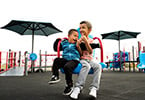 Engagement and friendship with peers of different capabilities |
Normalizes all levels of ability, encourages collaboration, eliminates stereotypes |
 Fun ways to get needed exercise outdoors |
Fine-tuning, adjustment, and development of motor skills |
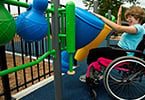 Enjoyable environment where kids of all ages and ability feel comfortable together |
Chances to build social skills, confidence, and self-esteem |
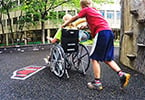 Multigenerational equipment for everyone to join in the fun |
Mutual understanding and community engagement that allows parents, grandparents, and caretakers to play with their children |
It's time for the fun part - discussing how your design can achieve these benefits.
Let's keep going!
SECTION 6 Designing an Inclusive Playground

Now that you have a strong understanding of what an inclusive playground and its components are, who it caters to, and why it's integral, we're going to break down how to design one.
The most critical things to remember and continually refer back to are the Me2®: 7 Principles of Inclusive Playground Design®, developed by PlayCore with Utah State University Center for Persons With Disabilities. Adhering to them will ensure your
playground is accessible to all.
01 Be Fair
Equitable Use
The play environment promotes fair use to people with diverse abilities.
03 Be Smart
Simple and Intuitive Use
The design is straightforward, making it easy to understand, allowing individuals to be successful and gain confidence through play.
05 Be Safe
Tolerance for Error
The play environment is tolerant of error by meeting current safety standards, considering unintentional actions, and promoting emotional security for personal growth and development.
07 Be Comfortable
Size and Space for Approach and Use
The play environment is comfortable for individuals with diverse sensory needs, body size, posture, mobility, environmental sensitivity, and motor control.
02 Be Included
Flexibility in Use
The play environment offers flexibility in use and accommodates everyone's right to play by being more usable by more people to the greatest extent possible.
04 Be Independent
Perceptible Information
The design communicates perceptible information and allows individuals to effectively explore, interact, and participate in sensory-rich play as independently as possible.
06 Be Active
Low Physical Effort
The play environment can be used efficiently, supporting diverse opportunities for children to engage in sustained, healthy physical activity, emphasizing social participation and cooperation.
01 Be Fair
Equitable Use
The play environment promotes fair use to people with diverse abilities.
02 Be Included
Flexibility in Use
The play environment offers flexibility in use and accommodates everyone's right to play by being more usable by more people to the greatest extent possible.
03 Be Smart
Simple and Intuitive Use
The design is straightforward, making it easy to understand, allowing individuals to be successful and gain confidence through play.
04 Be Independent
Perceptible Information
The design communicates perceptible information and allows individuals to effectively explore, interact, and participate in sensory-rich play as independently as possible.
05 Be Safe
Tolerance for Error
The play environment is tolerant of error by meeting current safety standards, considering unintentional actions, and promoting emotional security for personal growth and development.
06 Be Active
Low Physical Effort
The play environment can be used efficiently, supporting diverse opportunities for children to engage in sustained, healthy physical activity, emphasizing social participation and cooperation.
07 Be Comfortable
Size and Space for Approach and Use
The play environment is comfortable for individuals with diverse sensory needs, body size, posture, mobility, environmental sensitivity, and motor control.
Need an example to drive home the point? We have a few. Consider these scenarios that take several of these principles into account:

Not Inclusive
A current playground has a combination of sand and rocks for surfacing, which is not ideal for children with specific mobility devices.

Inclusive
A playground has accessible routes to the play structures. To make it safer and more accessible, the designer would swap out the surfacing for something like poured-in-place rubber.

Not Inclusive
A park has an enticing structure, but only stairs are available for access.

Inclusive
There should be no barriers to a child's ability to play, so the playground would need a ramp to allow kids to access the higher parts of play equipment.
While these are two great examples, it's integral to keep in mind that inclusive
playgrounds do not simply place accessible equipment in a particular part of a park. Instead, accessibility is infused throughout the entire design so that kids of all abilities can play together – no matter where they are in the playground. By adhering to the 7 Principles of Inclusive Playground Design, you can easily integrate accessibility to this degree into an entire playground.
Here are some inclusive design essentials to help make that happen:
Ramp Access
Upper Body Events
Graduated Levels
Cozy Spot
Seating & Shade
If you already have a playground designed and want to make it more inclusive, these principles and design essentials still apply. And you can re-design elements to make your already-established park or playground more inclusive.
How? Budget-minded playground planners have many options to transform an outdated play area into one that is inclusive. You can find funding partners that help make your dream of an inclusive playground on your community grounds possible. You can also opt for affordable products like smooth surfaces for the play space and equipment such as a high-backed spinner or swing.
Other budget-friendly inclusive playground structures include:
- Sensory Wave Climber
- Harmonic Chimes
- Sensory Spinning Seat
- Inclusive Sky Run Zip Track
- Rockin Robin
Besides being affordable, these options also observe the other principles of inclusive design, particularly safety, which we dig into next.
SECTION 7 Playground Safety Tips

Every inclusive playground should strive to follow the seven principles mentioned above, but paying close attention to safety may matter the most. That's because studies show that more than 200,000 kids are treated in emergency rooms each year for playground-related injuries. If your playground is unsafe, then children will not reap the benefits of inclusive play.
Luckily, you can make all playgrounds safe and entertaining by observing specific safety tips. They are:
- Fall surfaces should be shock-absorbing material like wood chips or rubber.
- The area under or around fall zones should be a minimum of six feet in all directions.
- Ladders steeper than 65 degrees should have hand grips and stairs with handrails on both sides.
- Choose soft seats that will not splinter or burn children.
- All corners should be rounded and smooth, with rolled or round capped edges.
- Officials should perform routine maintenance and regularly check for signs of wear and tear and broken or missing components.
- Children under four years should not play on horizontal ladders or climbing equipment.
- "Whirls" or "roundabouts" are best suited for children 5 to 12 years of age.
- Ensure that there is a line of sight to all playground areas to keep track of children as they move.
- Adults should make sure kids properly use playground equipment and carefully watch their child's activity.
While these are imperative for all playgrounds, an inclusive playground needs to take extra precautions. For example, to account for potential sensory or communication disorders, follow these tips:
- Look for enclosed playground areas.
- Use a unique ID bracelet or sticker with a phone number.
- Seek areas with exciting points of interest.
- Parents should scan for potential hazards unique to their child.
- Use the buddy system!
- Everyone should keep a watchful eye.
As important as design and monitoring are, the quality of materials involved matters substantially. From safety surfacing to swing sets to monkey bars, every component of your commercial playground equipment should not only be inclusive but be built to avoid potential injuries to young children.
Keep reading for more on this.
SECTION 8 Safe and Inclusive Playgrounds to Spark Inspiration
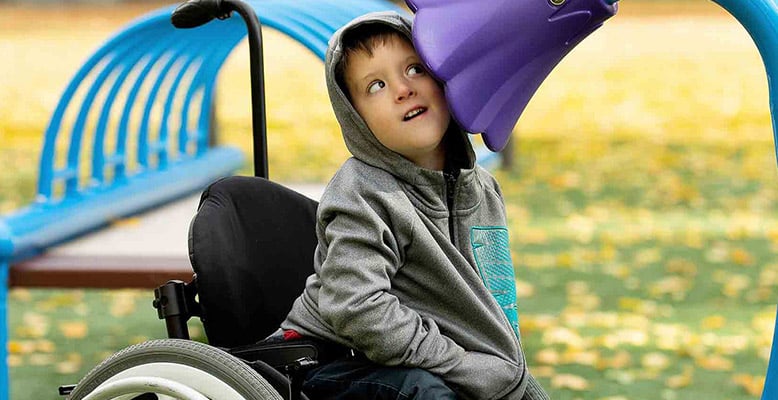
Everything we design and construct at MRC we make with safe, durable equipment that goes beyond accessibility. It's immersive. It's backed by independent research and based on guidelines developed by leaders in inclusive design.
Point blank: Our play and recreation designs and structures follow everything we've written so far and, most importantly, address the needs of the whole child.
They also look great and encourage fun. Take a look for yourself:
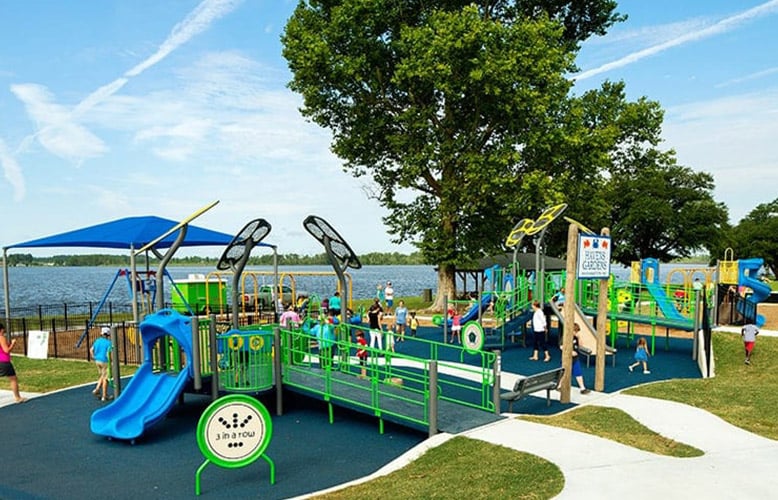
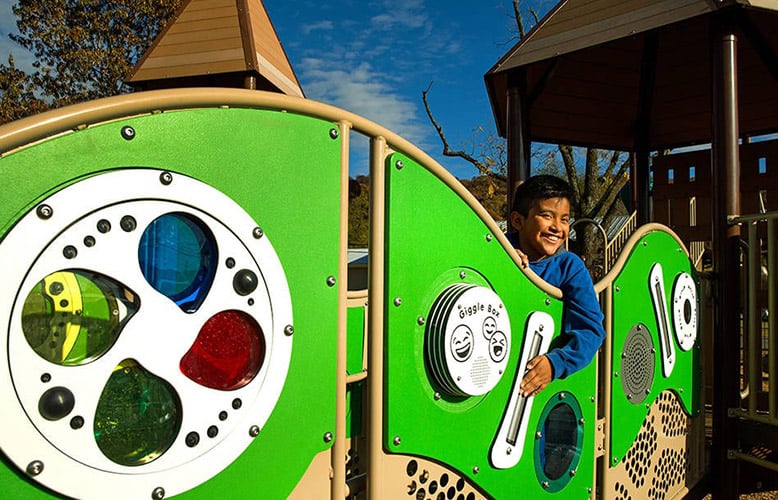
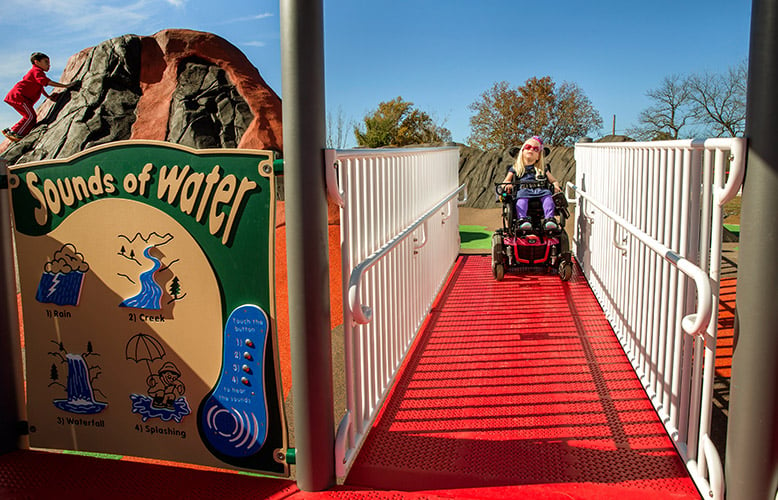
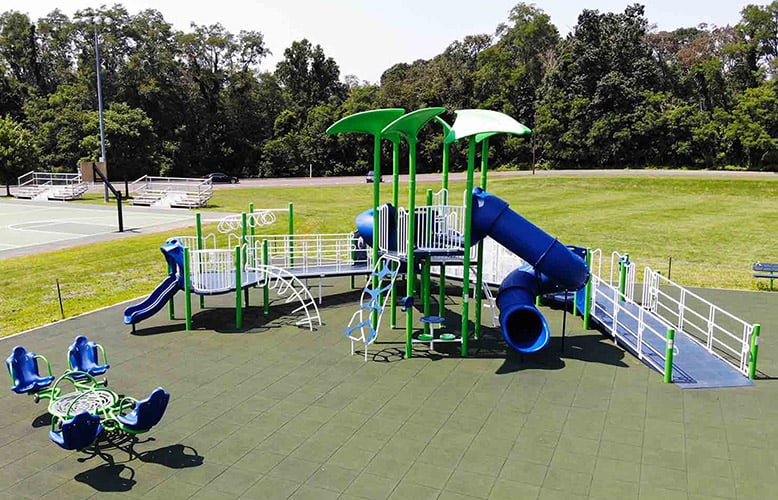
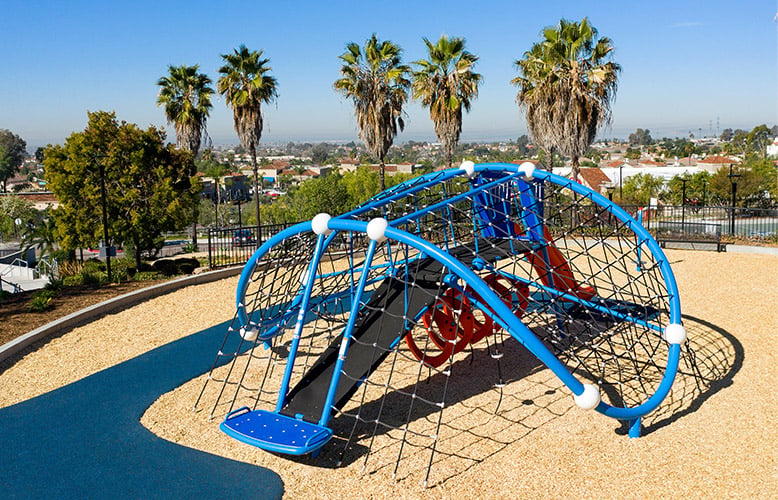
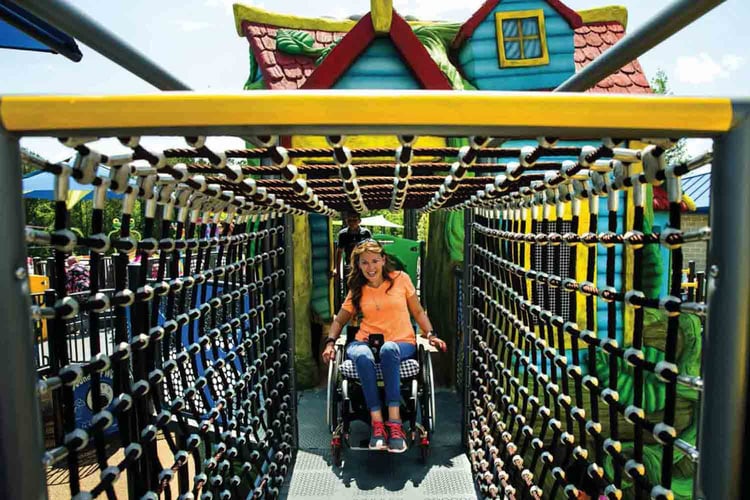






Itching to get going now? You're not going to want to miss our next section, where members from the MRC team tell all.
SECTION 9 Advice from Creators and Designers of Inclusive Playgrounds

By now, you're likely ready to get started on your project! But as we mentioned, there's still more information to know, and it comes straight from the play experts.
With that said, here is some advice on everything from planning to funding and what to expect when you finally meet with a playground specialist and kick off your project:
Prior to speaking with an experienced playground designer, it’s common to feel overwhelmed. Starting a playground project requires a lot of planning. Choosing an all-inclusive playground design for your project can sometimes add another layer of stress.
A good first step when selecting a playground specialist to work with you on your inclusive play environment is to do your homework on their past experience. Research your prospective playground specialist and see their completed projects, and how long they’ve been designing. If possible, go check out the quality of their work in the field. Get hands-on and see how you like every element of their design. A quality playground specialist will work with you to answer any questions you may have. In return, they should be asking you questions along the way that will help them design the perfect playground environment for your specific needs.
What are those questions? Here are the key elements to consider as well as questions to ask your playground specialist and yourself:
Space
The first thing to consider with any commercial playground project is your available space. Designing an inclusive playground does not necessarily require having a large footprint. A great inclusive playground can function in a compact space. Or, if space is not an issue, your design can get quite large. A quality playground design specialist will work within your available space to provide as much play value as possible.
Funding
Sometimes your available project budget may not be enough to build the inclusive playground of your dreams. Our partners at GameTime have compiled a detailed Funding Guide to help you make it possible. The guide is composed of grant opportunities from national corporations through local, state-specific sources.
Renderings and animation walkthroughs
A seasoned commercial playground design firm will be equipped with various in-house design tools that will help you visualize the project. At MRC, we have several CAD, SketchUp, and Lumion artists who take your available space into their design software and craft renderings and animations of your dream playground. Visual renderings and animated video walkthroughs will not only show you what your playground will actually look like, but can often aid in the fundraising process by giving people an impressive look at what you’re working on. Many inexperienced playground firms work through manufacturers to generate designs; or worse, simply pull a “cookie cutter pre-designed” playground from a catalog.
Budget
Another key consideration prior to beginning the design process: Your estimated available budget for the project. Items to calculate with your budget include:
- Playground equipment
- Freight Safety surfacing and curbing
- Certified installation
Some playground design firms will add additional charges for designs. Some of the best in the industry will not charge additional fees.
Push your playground designer to go beyond traditional inclusion
Inclusive play aims to create and foster play environments where everyone can play safely and comfortably. To us, this goes far beyond accommodating the physically disadvantaged. While the best commercial playground manufacturers go above-and-beyond by providing double-wide playground ramps as accessible routes of travel, they also have research backing the need for sensory elements. The best designers are working to ensure every inclusive playground is able to host multigenerational play. Providing outlets for multigenerational play like GameTime’s Expression Swing is a wonderful way to include people of all ages in play together. Budget permitting, don’t settle for an inclusive playground design that simply provides ramps. Push for a design that includes ramps, but also caters to a much larger percentage of people, regardless of their age or ability. It is best practice to include varying pieces of inclusive play components.
Not too bad, right? That’s what we thought - and we haven’t even gotten to the best part of it all yet which is the end result of all your hard work. You can see the pay off in one of your most recent projects, an inclusive playground design for the Field of Dreams project in Toms River, New Jersey. The team who helped bring Toms River Field of Dreams to life were dedicated to pushing the boundaries of inclusive play with our designers, which helped bring an incredible family’s dream to reality.
We were really pushed outside of the box to design something that was beyond physical disabilities, and address the needs of the whole child, in every child.
Matt Miller
Director of Marketing and Design Team Member
SECTION 10 Get Started

At MRC, we've dedicated ourselves to inclusive research and design, so we hope we've provided an in-depth understanding of the importance of inclusion and how to build your inclusive playground design. If you need to reference anything you've seen here again, please download a PDF copy of this page below.
You can also contact us today if you're ready to start building a playground that every child can enjoy.
Just reach out to us here.

Download the PDF Guide
Fill out the form for a downloadable PDF version of this guide you can reference later.
